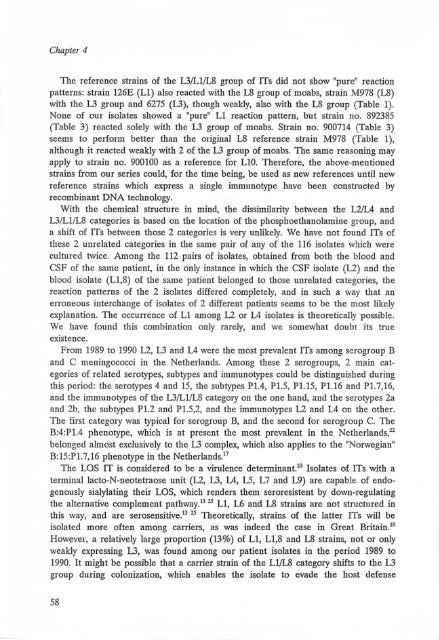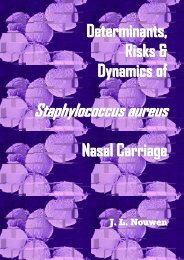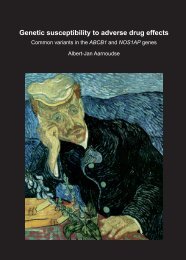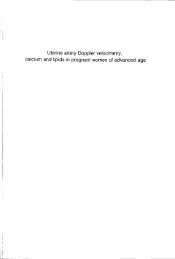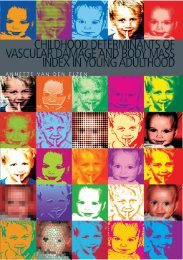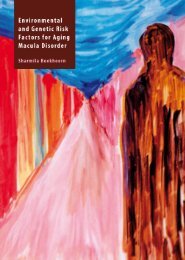An attempt at an epidemiological explanation - Epib.nl
An attempt at an epidemiological explanation - Epib.nl
An attempt at an epidemiological explanation - Epib.nl
- No tags were found...
You also want an ePaper? Increase the reach of your titles
YUMPU automatically turns print PDFs into web optimized ePapers that Google loves.
Chapter 4The reference strains of the L3/L1/L8 group of ITs did not show "pure" reactionp<strong>at</strong>terns: strain 126E (Ll) also reacted with the LS group of moabs, strain M978 (LS)with the L3 group <strong>an</strong>d 6275 (L3), though weakly, also with the LS group (Table 1).None of our isol<strong>at</strong>es showed a "pure" Lt reaction p<strong>at</strong>tern, but strain no. 892385(Table 3) reacted solely with the L3 group of moabs. Strain no. 900714 (Table 3)seems to perform better th<strong>an</strong> the original LS reference strain M978 (Table 1),although it reacted weakly with 2 of the L3 group of moabs. The same reasoning mayapply to strain no. 900100 as a reference for LlD. Therefore, the above-mentionedstrains from our series could, for the time being, be used as new references until newreference strains which express a single immunotype have been constructed byrecombin<strong>an</strong>t DNA technology.With the chemical structure in mind, the dissimilarity between the L2/L4 <strong>an</strong>dL3/L1/L8 c<strong>at</strong>egories is based on the loc<strong>at</strong>ion of the phosphoeth<strong>an</strong>olamine group, <strong>an</strong>da shift of ITs between those 2 c<strong>at</strong>egories is very u<strong>nl</strong>ikely. We have not found ITs ofthese 2 unrel<strong>at</strong>ed c<strong>at</strong>egories in the same pair of <strong>an</strong>y of the 116 isol<strong>at</strong>es which werecultured twice. Among the 112 pairs of isol<strong>at</strong>es, obtained from both the blood <strong>an</strong>dCSF of the same p<strong>at</strong>ient, in the on ly inst<strong>an</strong>ce in which the CSF isol<strong>at</strong>e (U) <strong>an</strong>d theblood isol<strong>at</strong>e (L1,8) of the same p<strong>at</strong>ient belonged to those unrel<strong>at</strong>ed c<strong>at</strong>egories, thereaction p<strong>at</strong>terns of the 2 isol<strong>at</strong>es differed completely, <strong>an</strong>d in such a way th<strong>at</strong> <strong>an</strong>erroneous interch<strong>an</strong>ge of isol<strong>at</strong>es of 2 different p<strong>at</strong>ients seems to be the most likelyexpl<strong>an</strong><strong>at</strong>ion. The occurrence of Ll among L2 or L4 isol<strong>at</strong>es is theoretically possible.We have found this combin<strong>at</strong>ion o<strong>nl</strong>y rarely, <strong>an</strong>d we somewh<strong>at</strong> doubt its trueexistence.From 1989 to 1990 U, L3 <strong>an</strong>d L4 were Ille most prevalent ITs among serogroup B<strong>an</strong>d C meningococci in the Netherl<strong>an</strong>ds. Among these 2 serogroups, 2 main c<strong>at</strong>egoriesof rel<strong>at</strong>ed serotypes, subtypes <strong>an</strong>d immunotypes could be distinguished duringthis period: the serotypes 4 <strong>an</strong>d 15, the subtypes P1.4, P1.5, Pl.15, Pl.16 <strong>an</strong>d P1.7,16,<strong>an</strong>d the immunotypes of the L3/L1/L8 c<strong>at</strong>egory on the one h<strong>an</strong>d, <strong>an</strong>d the serotypes 2a<strong>an</strong>d 2b, the subtypes P1.2 <strong>an</strong>d P1.5,2, <strong>an</strong>d the immunotypes U <strong>an</strong>d L4 on the other.The first c<strong>at</strong>egory was typical for serogroup B, <strong>an</strong>d the second for serogroup C. TheB:4:P1.4 phenotype, which is <strong>at</strong> present the most prevalent in the Netherl<strong>an</strong>ds,"belonged almost exclusively to the L3 complex, which also applies to the "Norwegi<strong>an</strong>"B:15:P1.7,16 phenotype in the Netherl<strong>an</strong>ds."The LOS IT is considered to be a virulence determin<strong>an</strong>t. 1o Isol<strong>at</strong>es of ITs with <strong>at</strong>erminal lacto-N-neotetraose unit (U, L3, L4, LS, L7 <strong>an</strong>d L9) are capable of endogenouslysialyl<strong>at</strong>ing their LOS, which renders them seroresistent by down-regul<strong>at</strong>ingthe altern<strong>at</strong>ive complement p<strong>at</strong>hway.1.l 25 Ll, L6 <strong>an</strong>d LS strains are not structured intbis way, <strong>an</strong>d are serosensitive 13 25 Theoretically, strains of tbe l<strong>at</strong>ter ITs will beisol<strong>at</strong>ed more often among carriers, as was indeed the case in Gre<strong>at</strong> Britain.lOHowever, a rel<strong>at</strong>ively large proportion (13%) of Ll, Ll,8 <strong>an</strong>d LS strains, not or o<strong>nl</strong>yweakly expressing L3, was found among our p<strong>at</strong>ient isol<strong>at</strong>es in the period 1989 to1990. It might be possible th<strong>at</strong> a carrier strain of the Ll/L8 c<strong>at</strong>egory shifts to the L3group during coloniz<strong>at</strong>ion, which enables the isol<strong>at</strong>e to evade the host defense58


